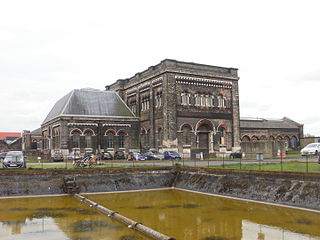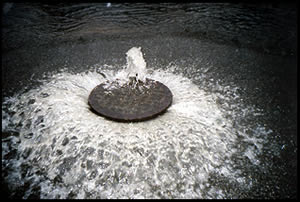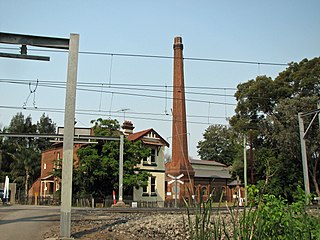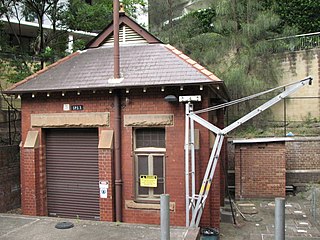
A sanitary sewer is an underground pipe or tunnel system for transporting sewage from houses and commercial buildings to a sewage treatment plant or disposal. Sanitary sewers are a type of gravity sewer and are part of an overall system called a "sewage system" or sewerage. Sanitary sewers serving industrial areas may also carry industrial wastewater. In municipalities served by sanitary sewers, separate storm drains may convey surface runoff directly to surface waters. An advantage of sanitary sewer systems is that they avoid combined sewer overflows. Sanitary sewers are typically much smaller in diameter than combined sewers which also transport urban runoff. Backups of raw sewage can occur if excessive stormwater inflow or groundwater infiltration occurs due to leaking joints, defective pipes etc. in aging infrastructure.

The Abbey Pumping Station is a museum of science and technology in Leicester, England, on Corporation Road, next to the National Space Centre. With four working steam-powered beam engines from its time as a sewage pumping station, it also houses exhibits for transport, public health, light and optics, toys and civil engineering.

The Anacostia River is a river in the Mid Atlantic region of the United States. It flows from Prince George's County in Maryland into Washington, D.C., where it joins with the Washington Channel to empty into the Potomac River at Buzzard Point. It is approximately 8.7 miles (14.0 km) long. The name "Anacostia" derives from the area's early history as Nacotchtank, a settlement of Necostan or Anacostan Native Americans on the banks of the Anacostia River.

The original Abbey Mills Pumping Station, in Mill Meads, East London, is a sewage pumping station, designed by engineer Joseph Bazalgette, Edmund Cooper, and architect Charles Driver. It was built between 1865 and 1868, housing eight beam engines by Rothwell & Co. of Bolton. Two engines on each arm of a cruciform plan, with an elaborate Byzantine style, described as The Cathedral of Sewage. Another of Bazalgette's designs, Crossness Pumping Station, is located south of the River Thames at Crossness, at the end of the Southern Outfall Sewer.

The Great Stink was an event in Central London in July and August 1858 during which the hot weather exacerbated the smell of untreated human waste and industrial effluent that was present on the banks of the River Thames. The problem had been mounting for some years, with an ageing and inadequate sewer system that emptied directly into the Thames. The miasma from the effluent was thought to transmit contagious diseases, and three outbreaks of cholera before the Great Stink were blamed on the ongoing problems with the river.

The District of Columbia Water and Sewer Authority provides drinking water, sewage collection and sewage treatment for the District of Columbia, in the United States. The utility also provides wholesale wastewater treatment services to several adjoining municipalities in Maryland and Virginia, and maintains more than 9,000 public fire hydrants in the District of Columbia. DC Water was created in 1996 when the District Government and the U.S. federal government established it as an independent authority of the District government.

A combined sewer is a type of gravity sewer with a system of pipes, tunnels, pump stations etc. to transport sewage and urban runoff together to a sewage treatment plant or disposal site. This means that during rain events, the sewage gets diluted, resulting in higher flowrates at the treatment site. Uncontaminated stormwater simply dilutes sewage, but runoff may dissolve or suspend virtually anything it contacts on roofs, streets, and storage yards. As rainfall travels over roofs and the ground, it may pick up various contaminants including soil particles and other sediment, heavy metals, organic compounds, animal waste, and oil and grease. Combined sewers may also receive dry weather drainage from landscape irrigation, construction dewatering, and washing buildings and sidewalks.

The Crossness Pumping Station is a former sewage pumping station designed by the Metropolitan Board of Works's chief engineer Sir Joseph Bazalgette and architect Charles Henry Driver at the eastern end of the Southern Outfall Sewer and the Ridgeway path in the London Borough of Bexley. Constructed between 1859 and 1865 by William Webster, as part of Bazalgette's redevelopment of the London sewerage system, it features spectacular ornamental cast ironwork, that Nikolaus Pevsner described as "a masterpiece of engineering – a Victorian cathedral of ironwork".

Moon Island is an island in Quincy Bay, in the middle of Boston Harbor, Massachusetts. It is the location of the Boston Fire Department Training Academy, and Boston Police Department shooting range. All of the land on the island is owned by the City of Boston but the island is under the jurisdiction of Quincy, Massachusetts. It is also part of the Boston Harbor Islands National Recreation Area.

Sanitary sewer overflow (SSO) is a condition in which untreated sewage is discharged from a sanitary sewer into the environment prior to reaching sewage treatment facilities. When caused by rainfall it is also known as wet weather overflow. Causes of sanitary sewer overflows include: Blockage of sewer lines, infiltration/Inflow of excessive stormwater into sewer lines during heavy rainfall, malfunction of pumping station lifts or electrical power failure, broken sewer lines. Prevention of such overflow events involves regular maintenance and timely upgrades of infrastructure.

The Washington Park Sewage Pumping Station is an historic wastewater pumping facility in Providence, Rhode Island. Its principal visible component is a concrete block structure, finished in stucco and topped by a hip roof, which is about 16 by 16 feet. This building stands atop a large cast-in-place concrete well, in which pumps and gate valves are housed. The facility was built in 1911 to pump raw sewage from the low-lying Washington Park area to the Field's Point wastewater treatment facility, which lies about 1,000 feet (300 m) to the north. The pump station is located well back from the street, behind a low brick distribution facility. It was added to the National Register of Historic Places in 1989.

The Bondi Ocean Outfall Sewer is a heritage-listed sewerage infrastructure at Blair Street, North Bondi, Waverley Municipality, New South Wales, Australia. The sewer line commences at the intersection of Oxford Street and College Street in Darlinghurst and then travels in a more-or-less easterly direction for 6.1 kilometres (3.8 mi) passing through a number of suburbs until it reaches Blair Street in North Bondi. It was designed and built by the Public Works Department between 1880 and 1889. It is also known as BOOS and Main Northern Ocean Outfall Sewer. The property is owned by Sydney Water, an agency of the Government of New South Wales. It was added to the New South Wales State Heritage Register on 15 November 2002.

Western Outfall Main Sewer is a heritage-listed former sewage farm outfall sewer and now ocean outfall sewer near Valda Avenue, Arncliffe, Bayside Council, New South Wales, Australia. It was designed by the New South Wales Department of Public Works, who built the sewer from 1895 to 1898. It is also known as SWSOOS No. 1, Western Main Carrier and Western Main Outfall Sewer. The property is owned by Sydney Water. It was added to the New South Wales State Heritage Register on 15 November 2002.

The Double Bay Compressed Air Ejector Station is a heritage-listed former sewage pumping station (SPS87) and now decommissioned sewerage infrastructure in Jamberoo Lane, Double Bay, adjacent to the rear boundary of 63 William Street, in the Municipality of Woollahra local government area of New South Wales, Australia. The site of the pumping station and the State Heritage Register curtilage is shown on SHR:01324–Plan 2019, reproduced on the internet page referenced here.

Sewage Pumping Station 67 is a heritage-listed sewage pumping station located on Grand Avenue, in the Sydney suburb of Camellia, in the City of Parramatta local government area of New South Wales, Australia. It was designed and built by the Metropolitan Water, Sewerage and Drainage Board from 1929 to 1930. It is also known as SPS 67 and SP0067. The pumping station is owned by Sydney Water. It was added to the New South Wales State Heritage Register on 15 November 2002.

Sewage Pumping Station 271 is a heritage-listed sewage pumping station located adjacent to 5 Carrington Road, Marrickville, Inner West Council, Sydney, New South Wales, Australia. It was designed and built by the New South Wales Public Works Department. It is also known as SPS 271. The property is owned by Sydney Water. It was added to the New South Wales State Heritage Register on 18 November 1999.

Sewage Pumping Station 27 is a heritage-listed former sewage pumping station situated in Callan Park, Rozelle, Inner West Council, Sydney, New South Wales, Australia. It is also known as SPS 27. The building is located on the southern side of King George Park. The property is owned by Sydney Water. It was added to the New South Wales State Heritage Register on 18 November 1999.

The Ultimo Sewage Pumping Station is a heritage-listed sewerage pumping station located at William Henry Street in the inner city Sydney suburb of Ultimo in the City of Sydney local government area of New South Wales, Australia. As a result of the construction of an elevated roadway along William Henry Street, the pumping station now fronts Pyrmont Street, with vehicles being required to enter via Quarry Street, then turning right into Pyrmont Street.

The Rushcutters Bay Sewage Pumping Station is a heritage-listed sewerage pumping station located at Rushcutters Bay Park in the inner city Sydney suburb of Rushcutters Bay in the City of Sydney local government area of New South Wales, Australia. It was designed and built by the New South Wales Public Works Department from 1902 to 1904. It is also known as Sewage Pumping Station 18 and SPS 18. The property is owned by Sydney Water, an agency of the Government of New South Wales. It was added to the New South Wales State Heritage Register on 18 November 1999.

Sewage Pumping Station 3 is a heritage-listed sewerage pumping station located near 1 Booth Street, Annandale, City of Sydney, New South Wales, Australia. The building is located adjacent to Johnstons Creek. It was built from 1902 to 1904 by the New South Wales Public Works Department. It is also known as SPS 3, SP0003, Booth Street Sewage Pumping Station and Annandale Sewage Pumping Station. The property is owned by Sydney Water. It was added to the New South Wales State Heritage Register on 18 November 1999.
























